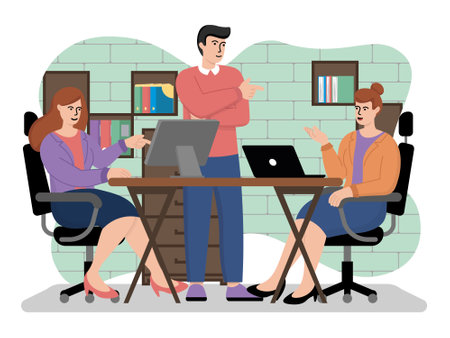Understanding Back Pain in British Workspaces
Back pain is an increasingly common complaint among office workers across the UK, impacting both productivity and quality of life. According to recent NHS statistics, nearly 1 in 6 people suffer from back pain at any given time, with a significant proportion being those who spend long hours behind a desk. The British workplace culture, which often values long hours and dedication, can inadvertently encourage prolonged periods of sitting and poor posture. Open-plan offices, hot-desking, and limited access to ergonomic furniture are also prevalent factors that contribute to this growing issue. Furthermore, cultural attitudes towards taking breaks or seeking help for discomfort may lead many employees to simply “crack on” despite their pain, rather than address underlying problems. This combination of environmental and cultural influences makes back pain a uniquely persistent challenge for British office workers today.
2. Common Risk Factors in UK Offices
Back pain is increasingly prevalent among British office workers, and it’s not just a matter of bad luck. The unique characteristics of UK office environments play a significant role in the development of musculoskeletal issues. Understanding these risk factors is the first step towards prevention and long-term recovery.
Ergonomic Issues
One of the most common culprits behind back pain in British offices is poor ergonomics. Many companies are housed in older buildings with limited space or outdated furniture, making it challenging to maintain an optimal desk setup. Insufficient lumbar support, non-adjustable chairs, and desks at improper heights can all contribute to chronic discomfort.
| Ergonomic Challenge | Impact on Back Health |
|---|---|
| Lack of adjustable chairs | Poor posture, increased lumbar strain |
| Incorrect monitor height | Neck and upper back tension |
| Limited workspace | Awkward sitting positions |
Sedentary Habits
The typical British workday often involves prolonged periods of sitting – sometimes for hours on end without meaningful breaks. The “tea break” tradition may offer brief respite, but it rarely translates into active movement. Extended sitting restricts blood flow, weakens core muscles, and places continuous pressure on the lower back.
Cultural Influence: “Stiff Upper Lip” Attitude
Another factor unique to UK office culture is the tendency to downplay discomfort. The classic British “stiff upper lip” approach means many workers ignore early warning signs of back pain or avoid seeking help until the problem becomes severe. This attitude can delay intervention and exacerbate injuries.
Summary Table: Key Causes in UK Offices
| Risk Factor | Description |
|---|---|
| Poor workstation ergonomics | Lack of supportive furniture or proper setup |
| Sedentary lifestyle | Minimal movement throughout the workday |
| Cultural reluctance to seek help | Tendency to ignore symptoms or self-manage pain |
Addressing these risk factors requires a proactive approach from both employers and employees. By recognising the challenges specific to British offices, it becomes possible to implement targeted strategies for prevention and promote a healthier workplace culture.

3. Prevention Strategies: Proactive Steps for British Employees
When it comes to tackling back pain among UK office workers, prevention is always better than cure. Let’s get practical about the steps you can take to protect your back while working in an office environment.
Workstation Adjustments: Setting Up for Success
A well-arranged workstation is essential. In the UK, employers are required by law to provide a safe working environment under Health and Safety regulations. Start with your chair: choose one with adjustable height, proper lumbar support, and a seat that allows your feet to rest flat on the floor. Your desk should let your forearms rest comfortably parallel to the floor, and your computer monitor ought to be at eye level to prevent slouching. Small changes like using a footrest or keyboard tray can make a world of difference.
Movement Routines: Keeping Active During the Workday
Sitting still for hours on end is a recipe for disaster. British health experts recommend standing up and stretching every 30 minutes—even if it’s just to pop the kettle on or have a quick wander around the office. Incorporate gentle stretches for your back, shoulders, and neck throughout the day. If you commute by train or bus, try getting off a stop early and walking the rest of the way. These habits not only support your spine but boost your overall wellbeing.
Employer Support: Building a Culture of Health
Prevention isn’t just down to individuals—employers play a crucial role too. Many UK workplaces now offer ergonomic assessments or sit-stand desks as part of their wellbeing initiatives. Don’t hesitate to speak with your HR department about any discomfort; it’s in everyone’s interest to keep staff healthy and productive. Forward-thinking companies encourage flexible working hours and regular breaks, helping reduce the risk of chronic back pain across the team.
By taking these proactive steps—adjusting your workspace, moving regularly, and seeking employer support—you’ll not only lower your risk of developing back pain but also set yourself up for a healthier, more comfortable work life in Britain’s ever-evolving office culture.
4. Recovery and Workplace Support
Recovering from back pain as a British office worker is not just about rest; it’s about making the most of available resources and embracing proactive changes at work. Many people in the UK turn to the NHS for guidance, but combining healthcare support with workplace adjustments delivers the best results.
Effective Recovery Methods
Successful recovery involves a mix of medical advice, self-care, and professional interventions. Here’s a quick breakdown:
| Method | Description | UK Context |
|---|---|---|
| GP Consultation | First step for persistent or severe pain. GPs assess your condition and refer you if needed. | NHS provides free GP appointments; consider booking promptly as waiting lists can be long. |
| Physiotherapy | Targeted exercises and manual therapy to relieve pain and improve mobility. | NHS physiotherapy is available via referral, but private options offer shorter wait times. |
| Pain Management Clinics | Specialist clinics offering multidisciplinary approaches for chronic cases. | Accessible through NHS referral, though availability varies by region. |
| Self-Management | Staying active, stretching, and pacing activities to avoid flare-ups. | NHS resources like “Back Pain Toolkit” offer practical advice for daily routines. |
Workplace Adjustments: Making Office Life Easier
The UK has clear workplace health regulations under the Health and Safety Executive (HSE) that require employers to support staff dealing with musculoskeletal issues. Practical adjustments can make a real difference:
- Ergonomic Assessments: Request a workplace assessment through HR or occupational health to ensure your desk setup supports your posture.
- Flexible Working Arrangements: Explore options like hybrid working or adjustable hours to reduce long commutes or prolonged sitting.
- Special Equipment: Ask for supportive chairs, standing desks, or lumbar cushions—many employers will fund these under their duty of care.
- Regular Breaks: Use reminders to stand up, stretch, or walk every 30-60 minutes. UK office culture increasingly embraces these habits post-pandemic.
- Mental Health Support: Chronic pain affects mood—consider using Employee Assistance Programmes (EAP) or talking therapies available via the NHS.
The British Approach: Realistic & Supported Recovery
No one-size-fits-all solution exists, but British office workers are well-placed to recover thanks to the NHS’s broad services and growing workplace awareness. The key is taking early action, communicating openly with your employer, and using all available support systems—because prevention is ideal, but effective recovery is always possible with the right approach.
5. A Personal Perspective: Navigating Back Pain at Work
Back pain is more than just a statistic for British office workers—it’s a daily reality that shapes routines, productivity, and even mental health. Speaking with colleagues from across London offices and regional hubs, a common thread emerges: many of us start our careers dismissing twinges as nothing, only to find them turning into persistent aches if left unchecked.
Everyday Struggles and Small Victories
Take Emily, an HR manager in Manchester, who recalls the embarrassment of having to stand up during meetings because sitting was too painful. Or James in Bristol, who found himself relying on painkillers just to get through month-end deadlines. Their stories are echoed in offices up and down the country—where high-pressure environments sometimes make it difficult to prioritise self-care or ask for ergonomic adjustments.
Practical Tips from Real Experiences
- Speak Up Early: The most common advice is not to suffer in silence. Whether it’s requesting a proper chair or flagging issues with your line manager, early intervention matters.
- Embrace Movement: Several employees shared how setting reminders for stretch breaks or short walks helped reduce stiffness and kept pain at bay.
- Desk Set-Up Matters: Investing time (and sometimes persuading IT) for monitor risers or supportive cushions made a significant difference in daily comfort.
Lessons Learned Along the Way
The biggest lesson? Back pain isn’t something to soldier through out of British stoicism. Ignoring discomfort only prolongs recovery and can lead to more serious issues down the line. Many found that by sharing their struggles, they not only received support but also discovered others facing similar challenges—creating a culture where well-being is openly discussed rather than brushed aside.
This personal insight underlines the importance of both individual responsibility and organisational support in managing back pain effectively within UK workplaces.
6. Promoting a Healthy Office Culture in the UK
Creating a supportive and health-focused office culture is vital for reducing back pain among British office workers. Beyond ergonomic adjustments, organisations must embrace policies and practices that prioritise both physical and mental wellbeing. A holistic approach not only minimises the risk of back pain but also fosters a more positive and productive work environment.
Workplace Policies That Make a Difference
Firstly, implementing flexible working arrangements—such as hybrid or remote work—can help employees vary their routines, reducing prolonged periods at desks. Encouraging regular breaks and movement is equally important; simple reminders to stand, stretch, or walk can make a tangible difference. Additionally, consider offering workstation assessments or subsidies for ergonomic equipment, ensuring everyone has access to proper support.
Mental Health Matters
The connection between mental health and physical discomfort should not be underestimated. Stress often manifests physically, exacerbating issues like back pain. Providing access to mental health resources, such as Employee Assistance Programmes (EAPs), mental health days, or in-office mindfulness sessions, demonstrates a genuine commitment to staff wellbeing. Openly acknowledging the pressures of modern office life helps break down stigma and encourages people to seek help early.
Encouraging Honest Conversations
One of the most powerful ways to promote wellbeing is by normalising discussions about physical health. Managers can set the tone by sharing their own experiences with back pain or workplace stress, making it easier for others to speak up without fear of judgement. Regular check-ins—both formal and informal—help identify problems before they become serious. Creating safe spaces where employees feel heard leads to better solutions and a stronger sense of community.
Building a Culture That Lasts
Sustained change requires ongoing education and engagement. Workshops on posture, movement, and self-care are practical ways to keep awareness high. Recognise and celebrate progress—whether it’s an employee championing healthy habits or the team completing a charity walk together. By embedding these values into everyday practice, British offices can move towards a future where back pain is addressed proactively, and everyone feels supported in their journey towards recovery and wellbeing.


